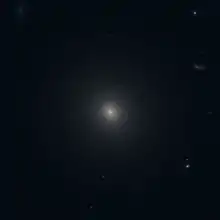NGC 1439
NGC 1439 is an elliptical galaxy located in constellation of Eridanus. Situated about 77 million light years away, it is a member of the Eridanus cluster of galaxies, a cluster of about 200 galaxies. It was discovered by William Herschel on 9 December 1784.
| NGC 1439 | |
|---|---|
 Hubble Space Telescope image of NGC 1439 | |
| Observation data (J2000 epoch) | |
| Constellation | Eridanus |
| Right ascension | 03h 44.498m [1] |
| Declination | −21° 55′[1] |
| Redshift | 1668 ± 8 |
| Distance | 23.5 Mpc (76.6 Mly) |
| Apparent magnitude (V) | 11.4[1] |
| Characteristics | |
| Type | E1[1] |
| Apparent size (V) | 2.4′ × 2.2′[1] |
NGC 1439 has a Hubble classification of E1, which indicates it is an elliptical galaxy with no extensions. It is moving from away from the Milky Way at a rate of 1,668 km/s. Its size on the night sky is 2.4' x 2.2' which is proportional to its real size of 54 000 ly.
NGC 1439 is an early-type galaxy. Despite their name, early-type galaxies are much older than spiral galaxies, and mostly comprise old, red-colored stars. Very little star formation occurs in these galaxies; the lack of star formation in elliptical galaxies appears to start at the center and then slowly propagates outward.[2]
Most of the galaxies like NGC 1439 are poor with dust. Howewer NGC 1439 contains more dust than usual.[3]

References
- Dunlop, Storm (2005). Atlas of the Night Sky. Collins. ISBN 978-0-00-717223-8.
- Howell, Elizabeth (2015). "Colossal Ancient Galaxies Die from the Inside Out". space.com. Retrieved 5 March 2017.
- https://iopscience.iop.org/article/10.1086/301440/pdf